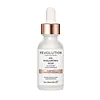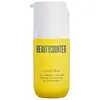What's inside
What's inside
 Key Ingredients
Key Ingredients

 Benefits
Benefits

 Concerns
Concerns

No concerns
 Ingredients Side-by-side
Ingredients Side-by-side

Water
Skin ConditioningPropanediol
SolventBis-Glyceryl Ascorbate
AntioxidantTetrahexyldecyl Ascorbate
AntioxidantPentylene Glycol
Skin ConditioningCoconut Alkanes
EmollientGlycerin
HumectantHydroxyethyl Acrylate/Sodium Acryloyldimethyl Taurate Copolymer
Emulsion StabilisingCurcuma Longa Root Extract
MaskingMyrciaria Dubia Fruit Extract
Skin ConditioningCurcumin
AntioxidantSodium Hyaluronate
HumectantPrunus Amygdalus Dulcis Oil
Skin ConditioningPhytic Acid
Citrus Aurantium Bergamia Fruit Oil
MaskingCoco-Caprylate/Caprate
EmollientPolyglyceryl-6 Polyricinoleate
EmulsifyingCitrus Nobilis Peel Oil
MaskingCitrus Aurantium Dulcis Flower Oil
AstringentEthylhexylglycerin
Skin ConditioningPotassium Sorbate
PreservativePhenoxyethanol
PreservativeDecanal
MaskingCitrus Aurantium Dulcis Peel Oil
MaskingIonone
AstringentEthyl Lactate
PerfumingVanillin
MaskingIsoamyl Acetate
SolventEthyl 2-Methylbutyrate
PerfumingMethoxyphenylbutanone
PerfumingOxacycloheptadec-10-En-2-One
PerfumingDimethylhydroxy Furanone
MaskingEthyl Propionate
PerfumingEthyl Cinnamate
PerfumingHexenyl Acetate
MaskingTriethyl Citrate
MaskingBenzyl Acetate
MaskingEthyl Acetate
PerfumingCitral
PerfumingLimonene
PerfumingLinalool
PerfumingWater, Propanediol, Bis-Glyceryl Ascorbate, Tetrahexyldecyl Ascorbate, Pentylene Glycol, Coconut Alkanes, Glycerin, Hydroxyethyl Acrylate/Sodium Acryloyldimethyl Taurate Copolymer, Curcuma Longa Root Extract, Myrciaria Dubia Fruit Extract, Curcumin, Sodium Hyaluronate, Prunus Amygdalus Dulcis Oil, Phytic Acid, Citrus Aurantium Bergamia Fruit Oil, Coco-Caprylate/Caprate, Polyglyceryl-6 Polyricinoleate, Citrus Nobilis Peel Oil, Citrus Aurantium Dulcis Flower Oil, Ethylhexylglycerin, Potassium Sorbate, Phenoxyethanol, Decanal, Citrus Aurantium Dulcis Peel Oil, Ionone, Ethyl Lactate, Vanillin, Isoamyl Acetate, Ethyl 2-Methylbutyrate, Methoxyphenylbutanone, Oxacycloheptadec-10-En-2-One, Dimethylhydroxy Furanone, Ethyl Propionate, Ethyl Cinnamate, Hexenyl Acetate, Triethyl Citrate, Benzyl Acetate, Ethyl Acetate, Citral, Limonene, Linalool
 Reviews
Reviews

Ingredients Explained
These ingredients are found in both products.
Ingredients higher up in an ingredient list are typically present in a larger amount.
Ethylhexylglycerin (we can't pronounce this either) is commonly used as a preservative and skin softener. It is derived from glyceryl.
You might see Ethylhexylglycerin often paired with other preservatives such as phenoxyethanol. Ethylhexylglycerin has been found to increase the effectiveness of these other preservatives.
Glycerin is already naturally found in your skin. It helps moisturize and protect your skin.
A study from 2016 found glycerin to be more effective as a humectant than AHAs and hyaluronic acid.
As a humectant, it helps the skin stay hydrated by pulling moisture to your skin. The low molecular weight of glycerin allows it to pull moisture into the deeper layers of your skin.
Hydrated skin improves your skin barrier; Your skin barrier helps protect against irritants and bacteria.
Glycerin has also been found to have antimicrobial and antiviral properties. Due to these properties, glycerin is often used in wound and burn treatments.
In cosmetics, glycerin is usually derived from plants such as soybean or palm. However, it can also be sourced from animals, such as tallow or animal fat.
This ingredient is organic, colorless, odorless, and non-toxic.
Glycerin is the name for this ingredient in American English. British English uses Glycerol/Glycerine.
Learn more about GlycerinPentylene glycol is typically used within a product to thicken it. It also adds a smooth, soft, and moisturizing feel to the product. It is naturally found in plants such as sugar beets.
The hydrophilic trait of Pentylene Glycol makes it a humectant. As a humectant, Pentylene Glycol helps draw moisture from the air to your skin. This can help keep your skin hydrated.
This property also makes Pentylene Glycol a great texture enhancer. It can also help thicken or stabilize a product.
Pentylene Glycol also acts as a mild preservative and helps to keep a product microbe-free.
Some people may experience mild eye and skin irritation from Pentylene Glycol. We always recommend speaking with a professional about using this ingredient in your routine.
Pentylene Glycol has a low molecular weight and is part of the 1,2-glycol family.
Learn more about Pentylene GlycolPotassium Sorbate is a preservative used to prevent yeast and mold in products. It is commonly found in both cosmetic and food products.
This ingredient comes from potassium salt derived from sorbic acid. Sorbic acid is a natural antibiotic and effective against fungus.
Both potassium sorbate and sorbic acid can be found in baked goods, cheeses, dried meats, dried fruit, ice cream, pickles, wine, yogurt, and more.
You'll often find this ingredient used with other preservatives.
Learn more about Potassium SorbatePropanediol is an all-star ingredient. It softens, hydrates, and smooths the skin.
It’s often used to:
Propanediol is not likely to cause sensitivity and considered safe to use. It is derived from corn or petroleum with a clear color and no scent.
Learn more about PropanediolSodium Hyaluronate is hyaluronic acid's salt form. It is commonly derived from the sodium salt of hyaluronic acid.
Like hyaluronic acid, it is great at holding water and acts as a humectant. This makes it a great skin hydrating ingredient.
Sodium Hyaluronate is naturally occurring in our bodies and is mostly found in eye fluid and joints.
These are some other common types of Hyaluronic Acid:
Learn more about Sodium HyaluronateWater. It's the most common cosmetic ingredient of all. You'll usually see it at the top of ingredient lists, meaning that it makes up the largest part of the product.
So why is it so popular? Water most often acts as a solvent - this means that it helps dissolve other ingredients into the formulation.
You'll also recognize water as that liquid we all need to stay alive. If you see this, drink a glass of water. Stay hydrated!
Learn more about Water